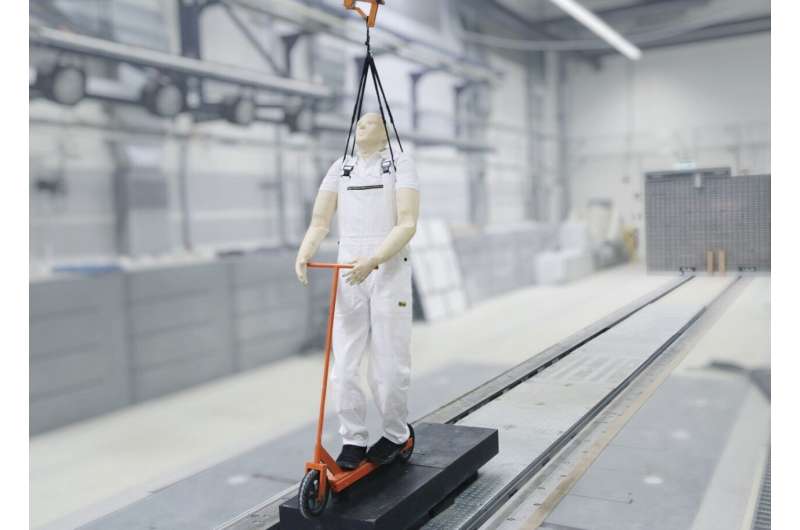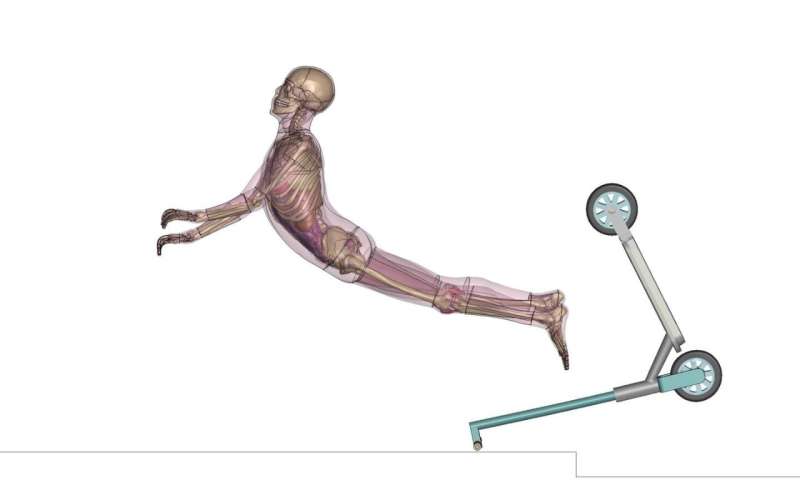Crash test dummies for e-scooters

Practical and environmentally friendly, e-scooters offer great flexibility. It is no wonder that more and more people are using this form of transport. However, this rise in popularity has been accompanied by an increase in accidents resulting in severe injuries.
The risk associated with these speedy runabouts is widely underestimated. In response to this, Fraunhofer researchers studied a typical accident scenario and the associated injuries as part of the HUMAD project. The experts also tested novel materials for helmets and protective gear. These could provide much better protection than conventional products.
The future of mobility is already here: a whole range of new vehicle types such as e-bikes, cargo bikes and electric scooters (also known as e-scooters) are whizzing around our cities. New opportunities for both flexible and environmentally friendly mobility are opening up—yet this also presents new dangers and safety risks.
The dangers associated with e-scooters, or "personal light electric vehicles" as they are officially termed, are quite clear. The German Federal Statistical Office's figures provide conclusive proof of this: in 2020, Germany recorded a total of 2,155 accidents involving e-scooters, within which five people died and 386 were seriously injured.
In 75 percent of the cases, the e-scooter driver was liable for the accident. Accidents in which the driver lost control of their vehicle were particularly common. The causes were often speeding or driving in the wrong direction. In many cases, alcohol played a role.
Crash tests and simulations
Researchers at the Fraunhofer Institute for High-Speed Dynamics, Ernst-Mach-Institut, EMI and the Fraunhofer Institute for Mechanics of Materials IWM, both of which are located in Freiburg, started a study on e-scooter crash safety within the framework of the HUMAD (Human Accident Dynamics) research project.
The aim was to investigate the course of typical accidents, determine the associated risk of injury and, at the same time, assess the suitability of protective equipment such as helmets and knee protectors. Fraunhofer EMI was responsible for the crash tests, while the team at Fraunhofer IWM analyzed the protective equipment. Both institutes have extensive experience in accident research.
Dr. Matthias Boljen, head of the Human Body Dynamics research group at Fraunhofer EMI, and his team used the example of a collision with a curb to focus on a very common type of e-scooter accident: single-vehicle collision (an accident not involving another road user).
"We worked with a crash test dummy, just like in crash tests conducted in the automotive industry. The dummy was placed on the replica e-scooter model and driven against a curb at angles of 60° and 90° and at speeds of 10, 20 and 30 km/h," explains Boljen.
During the tests, high-speed cameras showed how the body is catapulted into the air, flying over the handlebars, and flung several meters—depending on the impact speed—before crashing onto the ground. The crash tests demonstrated that serious injuries, in particular head injuries, can occur for all tested scenarios. "It was painful just watching the videos during the analysis," says Boljen. The knees are also at risk of injury.
Different variables: speed and collision angle
In parallel to the crash tests, Boljen and his team also analyzed the accident scenario in finite element simulations. The e-scooter and driver were digitally reproduced and the laws of conservation of momentum, mass and energy as well as the material properties of the vehicle and human model were defined. In the analysis, the simulation software showed which accelerations act on the head and knees.

The experts then used these values to determine the probability of certain injuries occurring to these body parts. "The crash tests with the dummy and numeric simulations with the human model both led to the same conclusion," explains Boljen. Even at a seemingly low speed of only 10 km/h, a collision at a 90° angle results in enormous accelerations of 170 g on the human body.
Wearing a helmet and protective gear is therefore highly recommended, as these decrease the probability of serious injuries. "However, no helmet can prevent the accelerations acting on the head in the event of a direct impact; they can only reduce some components of these to a certain extent. Strictly speaking, the risk of traumatic brain injury exists whether the driver wears a helmet or not," explains Boljen.
Need for research on helmets and protective gear
The researchers also discovered that the head impact speed measured in the simulation exceeds the maximum impact speed of 5.4 m/s stipulated in test standard DIN EN 1078 for bike helmet safety. In other words, conventional bike helmets and protective gear reduce the severity of the impact, but do not offer complete protection in collisions with hard objects.
This is where the expertise of the researchers at Fraunhofer IWM comes into play. For more than 50 years, they have been analyzing materials and assessing their suitability for certain applications. For this purpose, they also use crash tests and perform other tests to determine mechanical effects on materials. In HUMAD, they investigated the suitability and protective effect of new materials.
Innovative protection concepts based on bionics
Dr. Jörg Lienhard, responsible for lightweight construction in the Component Safety and Lightweight Construction business unit, explains: "Protective gear often uses plastics with a honeycomb structure. Our tests in the laboratory showed that materials with a TPMS (triply periodic minimal surface) structure offered much better protection against kinetic effects." The TPMS structure is characterized by repeating elements that form an "airy" open structure.
This structure is particularly good at distributing kinetic energy from shocks across the surface area, therefore reducing the pressure on impact areas. The concept originates from bionics, taking inspiration from nature. For example, the chitin exoskeletons of insects have this type of structure.
TPMS helmets and protective gear could be 3D printed using all kinds of materials. According to Fraunhofer IWM expert Lienhard, besides the FDM (fused deposition modeling) process for thermoplastics and conventional stereolithography, the DLP (digital light processing) method is particularly well suited for large-scale production of plastic structures.
It is similar to stereolithography in that the workpiece is built layer by layer. In contrast, however, DLP uses UV light generated by a projector, meaning that the entire layer can be cured at once. Several layers on top of each other give the material its desired form and structure. The material is cured using irradiation. At unexposed areas, the material simply drains off, leaving behind cavities that are characteristic of TPMS materials.
3D printing processes are very flexible and enable safety-related components or even vehicle parts to be individually produced for each application and its typical hazard profile—with DLP, this is now possible on a larger scale.
Conclusion of the HUMAD project: thanks to their small space requirement and flexibility, e-scooters offer an environmentally friendly solution for mobility in urban areas. However, it is important to treat them like you would a car—driving safely and responsibly. A helmet and protective gear should always be worn where possible.
Looking to the future of urban mobility, Fraunhofer researchers are hopeful that protective equipment such as helmets and knee protectors as well as special light crash absorbers, which are specifically designed for certain vehicles and application scenarios, will be made available.
Fraunhofer experts are already planning the next phase of crash tests and simulations. These will also investigate the driver's reflex movements during an accident and how these affect the risk of injury.




















